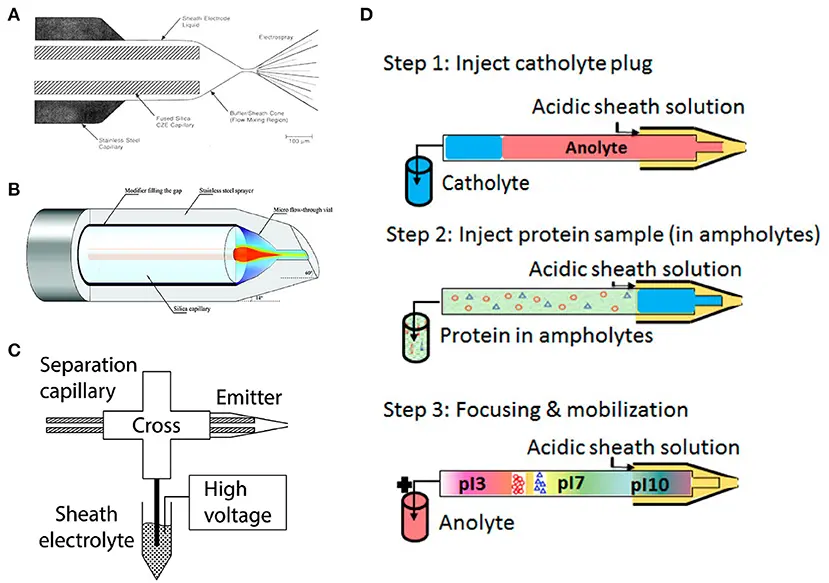Capillary Isoelectric Focusing (cIEF) is an advanced electrophoretic method used for the precise separation and analysis of proteins and peptides based on their isoelectric points (pI). By miniaturizing the traditional isoelectric focusing into a narrow capillary tube, cIEF offers remarkable resolution, sensitivity, and speed making it a vital tool in proteomics, biopharmaceutical quality control, and clinical diagnostics.
What Is Capillary Isoelectric Focusing?
cIEF combines the fundamental principle of isoelectric focusing with the benefits of capillary electrophoresis. In cIEF, a narrow fused silica capillary is filled with a mixture of sample proteins and ampholytes to establish a stable pH gradient under an applied electric field.
Proteins migrate within the capillary until they reach the region where the pH equals their isoelectric point (pI), the pH at which they carry no net charge, and focus sharply at that position. This allows separation of proteins differing by as little as 0.01 pH units.
How Does cIEF Work?
- Sample Preparation: Proteins or peptides are mixed with carrier ampholytes which help establish the pH gradient.
- Capillary Filling: The sample/ampholyte mixture fills the capillary.
- Electric Field Application: A high voltage is applied across the capillary, causing proteins to migrate and focus at their respective pI zones.
- Detection: The focused proteins are detected in the capillary by UV absorbance, fluorescence, or by coupling to mass spectrometry.
- Mobilization: Proteins can be mobilized past a detection window either chemically (changing the pH) or by pressure to generate an electropherogram.
Advantages of Capillary Isoelectric Focusing
- High Resolution: cIEF can separate protein isoforms with very subtle charge differences, often less than 0.01 pH units.
- Small Sample Volume: Requires minimal amounts of sample typically nanoliters to microliters.
- Fast Analysis: Runs typically complete in under an hour, often in minutes.
- Automation Friendly: Easily automated for high throughput analysis in research and quality control.
- Integration Capability: Compatible with various detectors and analytical techniques including mass spectrometry.
- Reduced Heat Generation: Capillary format provides better heat dissipation, allowing higher voltages and faster runs without overheating.
Applications of cIEF
- Protein Characterization: Differentiating protein isoforms and post-translational modifications like phosphorylation or glycosylation.
- Biopharmaceutical Quality Control: Characterization of monoclonal antibodies, biosimilars, and other therapeutic proteins to detect charge variants and impurities.
- Clinical Diagnostics: Detection of hemoglobin variants and other clinically relevant protein isoforms.
- Biomarker Discovery: High-resolution profiling of complex biological samples for biomarker identification.
- Proteomics Research: Studying protein heterogeneity in cells, tissues, and biofluids.
Recent Innovations in cIEF Technology
1. Integration with Mass Spectrometry (cIEF-MS)
Coupling cIEF with MS enables direct identification and characterization of focused proteins and peptides. Recent advances in interface design have improved sensitivity and throughput, critical for proteomics and biomarker research.
2. Automated cIEF Systems
New commercial cIEF instruments feature full automation for sample loading, focusing, mobilization, and data acquisition — increasing reproducibility and throughput in clinical and industrial labs.
3. Microfluidic cIEF Devices
Lab-on-a-chip microfluidic platforms integrate cIEF separation with downstream analysis steps in a compact format. These devices offer rapid processing and the potential for point-of-care diagnostics.
4. Improved Ampholyte Formulations
Enhanced carrier ampholytes provide more stable and reproducible pH gradients, improving separation quality and reproducibility.
5. Multiplexed cIEF
Developments in multiplexed capillary arrays allow parallel processing of multiple samples, significantly increasing throughput for large-scale studies.
Challenges and Future Directions
- Interface Optimization: Continued improvements in coupling cIEF with MS and other detection methods are critical.
- Sample Complexity: Strategies to handle complex biological samples with dynamic range challenges.
- Single-Cell Proteomics: Adapting cIEF to single-cell level analysis to understand cellular heterogeneity.
- Artificial Intelligence: Incorporating AI and machine learning to analyze complex cIEF data and identify subtle patterns.
Conclusion
Capillary Isoelectric Focusing is a cutting-edge technique that combines the principles of isoelectric focusing with the advantages of capillary electrophoresis to deliver unmatched resolution and speed for protein separation. With ongoing innovations in automation, detection, and microfluidics, cIEF continues to expand its role in proteomics, biopharmaceuticals, and diagnostics making it an indispensable tool for scientists and clinicians alike.
